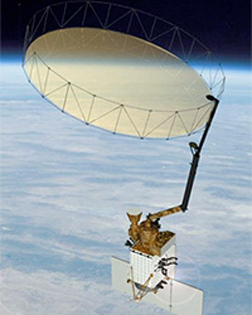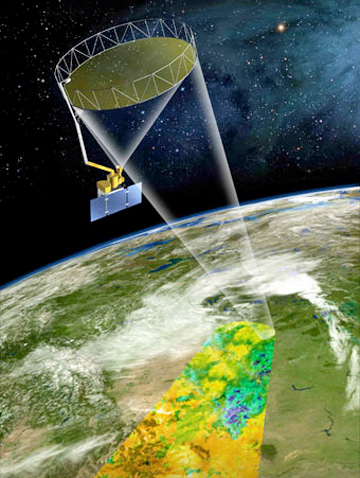[SatNews] The NASA Jet Propulsion Laboratory successfully deployed the mesh reflector and boom aboard the Soil Moisture Active Passive (SMAP) spacecraft, a key milestone on its mission to provide global measurements of soil moisture.
Launched on January 31st, SMAP represents the future of Earth Science by helping researchers better understand our planet. SMAP's unmatched data capabilities are enabled in part by the largest spinning mesh reflector ever deployed in space, designed and built by Astro Aerospace, a Northrop Grumman Corporation (NYSE:NOC) company. The reflector and boom are a critical system for SMAP, allowing the observatory to measure soil moisture levels around the world every two to three days.
SMAP is the first application of Astro Aerospace's new AstroMesh-Lite® reflector. This ultralight and extremely stiff reflector is ideally suited for high frequency communications and radar applications. Through the detection of radar emissions reflected off the soil, SMAP data will help improve weather and climate prediction models by increasing our understanding of the processes that link Earth's water, energy and carbon cycles.
SMAP also will identify whether soil moisture is in a frozen or thawed state, which will be used to detect changes in growing season length to help scientists better understand how much carbon plants absorb from the atmosphere each year. SMAP data will also be used to improve flood prediction and drought monitoring capabilities.
As the satellite orbits Earth, the 20-foot mesh reflector will spin atop the spacecraft at nearly 15 revolutions per minute, providing a conically scanning antenna beam at 40 degrees off nadir to produce a 621 mile wide measurement swath enabling the entire globe to be mapped every 2-3 days.

Artistic rendition of the AstroMast after deployment.
Image courtesy of Astro Aerospace.
Although the requirements of the mission are complex, the SMAP reflector weighs only 56 pounds. The extremely stiff boom, which holds the reflector in position and reduces deflections caused by the spin rate, weighs 55 pounds. With the remaining launch restraint equipment weighing approximately 15 pounds, the entire system totals a mere 127 pounds.
"The AstroMesh Reflector is a central feature of the SMAP spacecraft, which will be used to help monitor soil moisture and thus provide critical data about the state of our planet," said John A. Alvarez, general manager, Astro Aerospace.
The SMAP observatory is currently on a 426-mile near-polar, sun-synchronous orbit, with equator crossings at 6:00 a.m. and 6:00 p.m. Following the reflector's deployment and a series of instrument tests, SMAP will slowly be spun up and is scheduled to begin science operations in early May. SMAP is designed to operate for a minimum of three years and is managed for NASA's Science Mission Directorate, Washington, by NASA's Jet Propulsion Laboratory, Pasadena, California.



